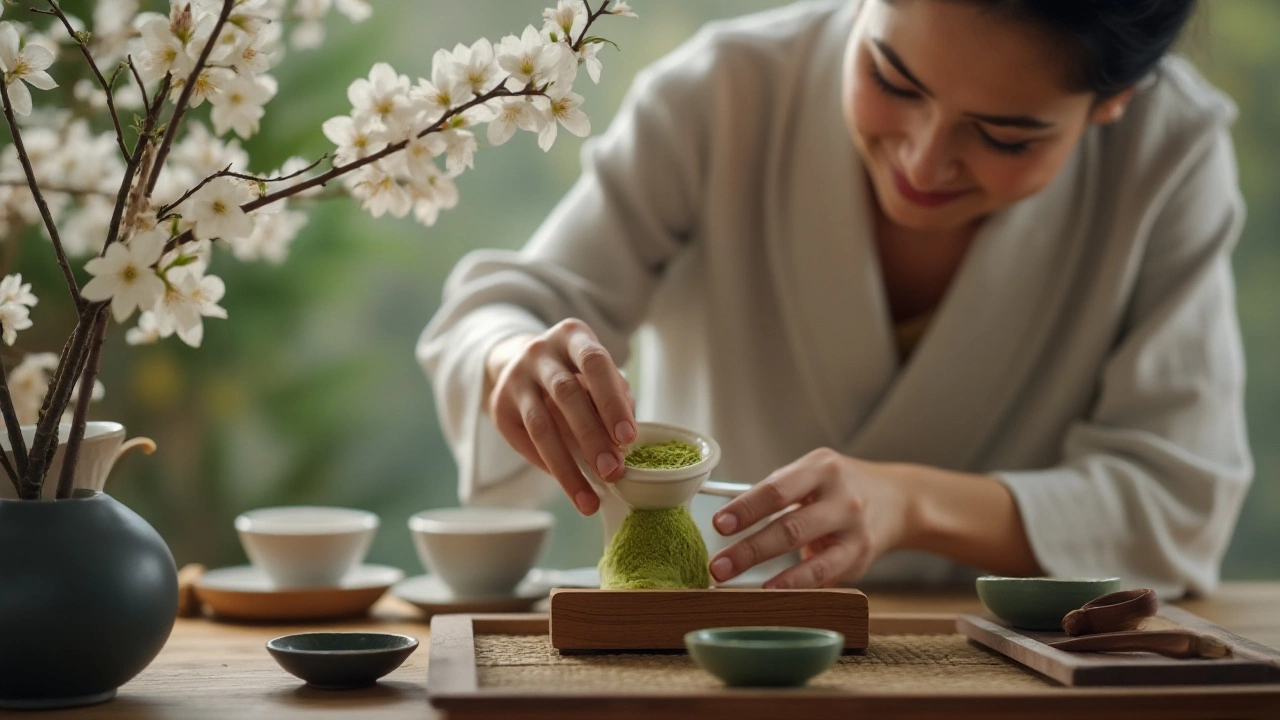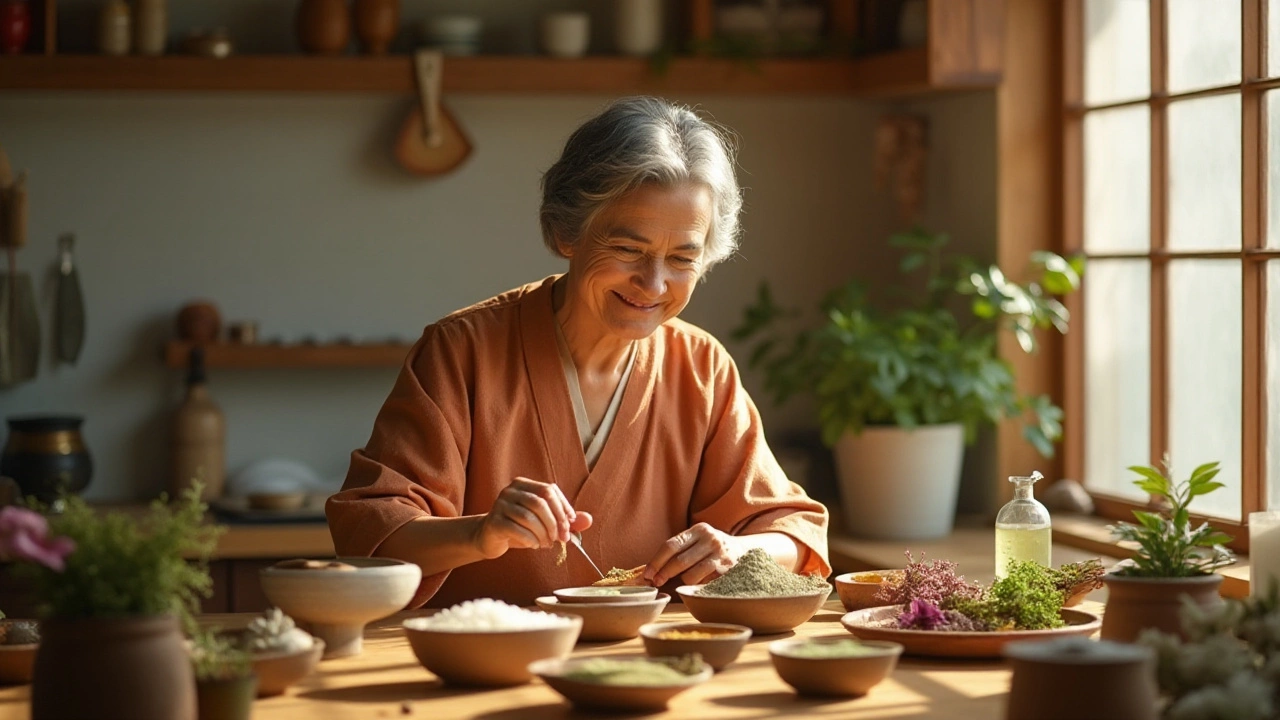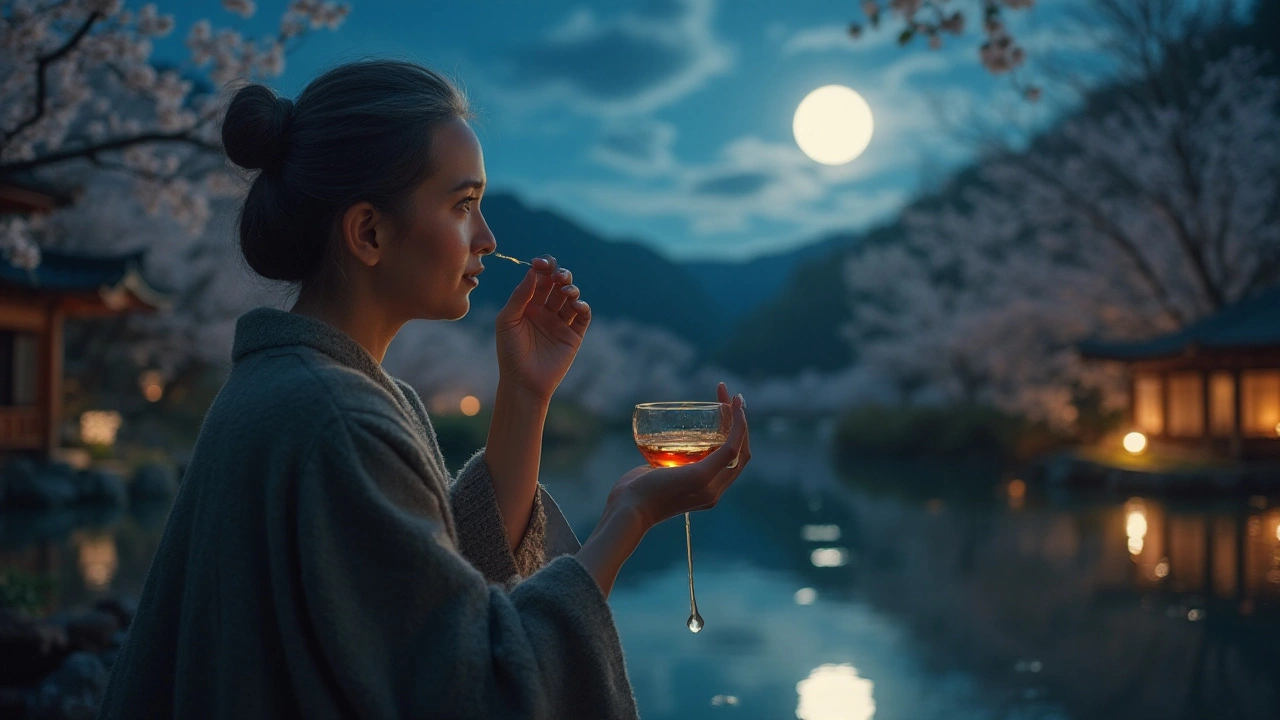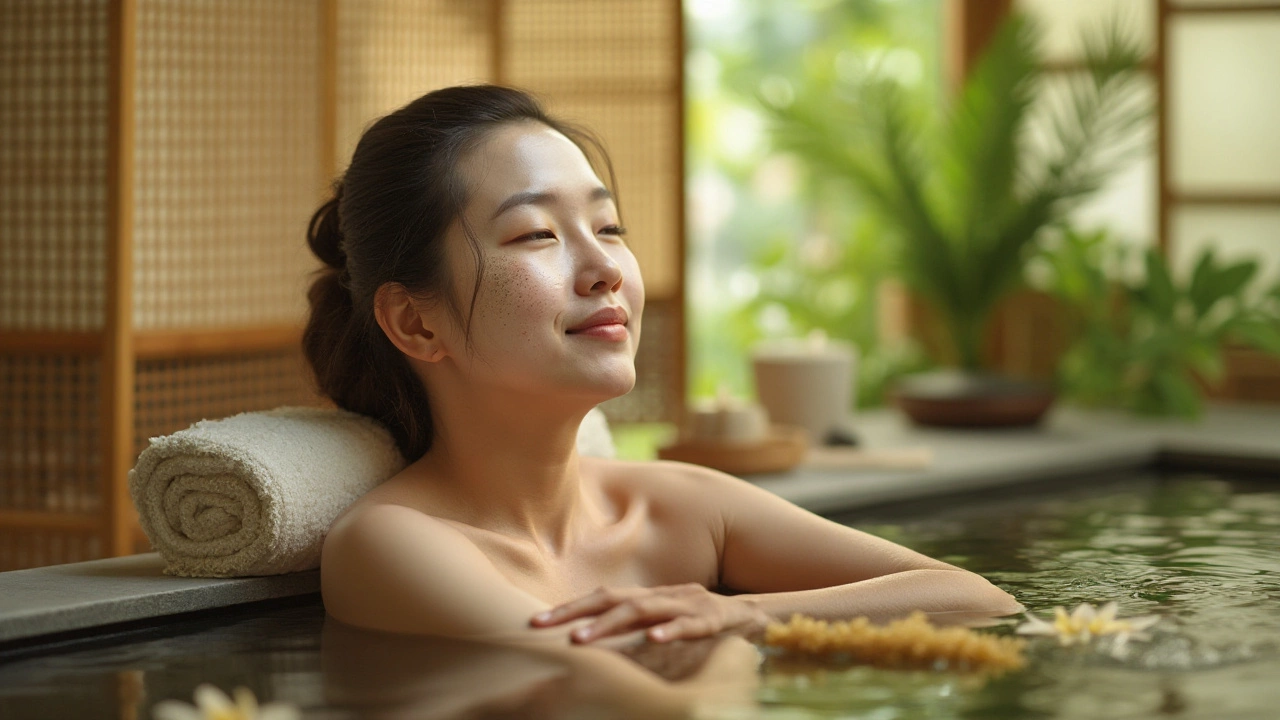Japan's rich history of natural beauty remedies offers something truly special for those seeking to reduce wrinkles without harsh chemicals. These restorative practices blend the pure charm of nature with the elegance of time-honored traditions.
Imagine a skincare regimen where the soothing aroma of green tea and the silky feel of rice water work together, gently polishing away the years. Or, the nourishing touch of tsubaki oil, a historical favorite, bringing vitality back to your skin. It's more than just beauty; it's about cherishing one's age with grace.
Come with me on a journey into these fascinating and effective rituals that are more than just treatment options—they're an art form in themselves, celebrated and passed down through generations.
The Beauty of Green Tea
Green tea, steeped in history and tradition, is more than just a delightful beverage in Japan; it's a cornerstone of healthy living and renowned for its anti-aging properties. This potent brew, rich in antioxidants called catechins, plays a crucial role in protecting the skin against damage from free radicals, which can accelerate the aging process and deepen wrinkle lines. Beyond that, green tea is celebrated for its ability to soothe inflammation and redness, making it a staple in skincare routines focused on achieving clear, youthful skin. The Japanese have long understood the multifaceted benefits of green tea, both consumed as a drink and applied topically as a tonic. Imagine a culture where sipping tea is as much about nurturing the skin as it is about enjoying a moment of peace.
Many people around the world now embrace green tea's multifunctional uses. Whether consumed or used in skincare products, its natural compounds are known to rejuvenate the skin from the inside out. It’s intriguing how something so simple can offer such profound results. Japanese skincare brands often infuse green tea extracts into their products, creating moisturizers and serums that promise to diminish wrinkles and enhance the skin's texture over time. This isn’t just marketing fluff; there's genuine science underpinning these claims. In one notable study, it was found that regular topical application of green tea can significantly improve skin elasticity, adding another reason to incorporate it into one’s daily regimen. Given its effectiveness, it’s no wonder that green tea is a popular ingredient in anti-aging treatments worldwide, including the dynamic field of Japanese skincare.
"Green tea possesses strong antioxidant properties that help prevent oxidative stress to the skin," remarks a spokesperson from the Dermal Institute. "It's becoming increasingly popular in the West but has been a key beauty secret in Japan for ages."
Another attractive quality of green tea is its versatility. From matcha masks to refreshing compresses made using its cooled brew, there are many ways to let green tea work its magic on the skin. The high concentrations of vitamins E and B2 in green tea speak to its ability to promote healthy skin cell turnover and maintain collagen levels. This process helps the skin retain its firmness and glow, two essential factors in minimizing the appearance of wrinkles. Have you ever indulged in a facial steam infused with green tea leaves? This age-old technique, loved for its detoxifying qualities, opens up pores and imparts a healthy glow, further illustrating green tea's unique place in holistic skincare. As a significant part of the Asian beauty landscape, it continues to be revered for its elegance and effectiveness.
For anyone seeking a gentle yet profound approach to aging gracefully, green tea offers an ideal solution. Its non-invasive nature makes it suitable even for those with sensitive skin. Plus, its gentle aroma adds a layer of sensory pleasure to beauty rituals, transforming them into calming experiences. Imagine including just a few tablespoons of freshly brewed green tea into your evening bath; not only does this help neutralize free radicals in the body, but it also provides a spa-like experience right in your home. With all these benefits coiled into a single plant, it's clear why green tea is often hailed as a marvel of nature. Embrace the heritage of Japanese skincare, and let green tea guide you towards a healthier, more vibrant appearance.

The Magic of Rice Water
Rice water holds a cherished place in the beauty rituals of Japan, renowned for its gentle yet effective nourishing properties. This humble ingredient, rooted deeply in Japanese tradition, is said to have been used by ancient court women for its ability to maintain youthful, luminous skin. Now, let us embark on an exploration of why rice water continues to captivate beauty enthusiasts across the world.
Scientifically speaking, rice water is rich in vitamins and minerals, including Vitamin E, B vitamins, and antioxidants, which contribute to its effectiveness as a *skincare* agent. The starchy liquid derived from rinsing or boiling rice contains inositol, known for promoting cell growth and slowing the signs of aging. In a world focused on harsh chemical treatments, this natural solution provides a kinder yet potent alternative for those aiming to keep wrinkles at bay.
History and Cultural Significance
The tale of rice water begins in the Heian period of Japanese history. Legend has it that the hair of the court women, known as Kamogawa no Nyōgo, owed its luster and length to baths in rice water. Over centuries, rice water became a staple in households, symbolizing sustenance and beauty. Today, it continues to be a testament to the minimalist beauty philosophy of Japan, emphasizing holistic care over cosmetic quick fixes.
"Using rice water dates back to at least the 8th century in Japan. It's more than a practice; it's like an art of living." — Dr. Masami Matsuyama, Historian in Japanese Culture.
Beyond Japan's borders, cultures across Asia have embraced the nurturing properties of rice water. Its gentle nature makes it suitable even for sensitive skin types, free from additives that often lead to irritation. The process of creating rice water at home is straightforward, reinforcing the idea that beauty rituals need not be expensive or elaborate to be effective.
DIY Rice Water Toner
Creating your own rice water toner is a simple process and can be incorporated seamlessly into your skincare routine. Follow these straightforward steps:
- Begin with one cup of organic rice, ensuring it is free from pesticides and chemicals.
- Rinse the rice thoroughly to remove any impurities.
- Add two cups of water to the rinsed rice, letting it soak for at least 30 minutes.
- Strain the liquid into a clean container, capturing the nutrient-rich water.
- Store the rice water in the refrigerator and use it within a week for freshness.
Incorporating rice water into your daily regimen involves more than just application; it's about embracing a mindset that values both patience and persistence. While results may not be instantaneous, the long-term benefits mirror the timeless beauty of those who advocate for its use.
Amidst an era where skincare trends shift with fleeting regularity, rice water remains a *Japanese remedy* that embodies the essence of grace, taking center stage as a faithful companion in the journey to radiant, wrinkle-free skin. Its magic lies not just in its liquid gold texture but in its ability to intertwine history, culture, and nature into one remarkable elixir.

Embracing Tsubaki Oil
The enchanting story of tsubaki oil begins on the lush and scenic islands of Japan, particularly on Shodo Island, known for its stunning camellia trees. Tsubaki oil, extracted from the seeds of these trees, has been cherished for centuries in Japanese beauty rituals. This versatile oil boasts a rich history and is celebrated for its rejuvenating properties that help diminish the appearance of fine lines and wrinkles. But what makes it so effective? Its secret lies in its high concentration of oleic acid, a fatty acid that is remarkably compatible with human skin. This allows the oil to penetrate deeply, providing nourishment and moisture without clogging pores, making it ideal for all skin types.
Incorporating tsubaki oil in daily skincare isn’t just about the oil itself, but about embracing a holistic approach to beauty that stems from Japan's understanding of nature. Using it nightly can transform your skincare routine into a spa-like experience, where gentle massages help improve circulation while enhancing the oil's absorption. It's fascinating how one ingredient can integrate so seamlessly into modern cosmetics while retaining such ancient roots. The anti-inflammatory properties of tsubaki oil also assist in calming irritated skin, making it an especially good choice for those with sensitive skin concerns.
"The benefits of tsubaki oil go beyond moisturizing; it acts as a barrier against pollutants, aiding the skin in its natural restoration process." — Sakura Hayashi, Japanese Beauty ExpertThis benefit is particularly crucial in today’s urban environments where pollution is a significant cause of premature aging. Using products rich in tsubaki oil creates a protective shield for your skin against harsh external aggressors, ensuring your complexion remains smooth and youthful. A study by the Tokyo University of Agriculture found that regular application of tsubaki oil led to an improvement in skin elasticity and a reduction in the depth of wrinkles in a significant percentage of participants.
Whether used alone or blended with other favorite ingredients in anti-aging treatments, integrating tsubaki oil into your skincare regime can yield remarkable results. Here’s a simple DIY treatment: warm a few drops of the oil between your hands and gently press them over your face. Allow it to absorb fully before applying any additional products. This not only relaxes facial muscles but also promotes deeper hydration, giving you skin that feels as soft as it looks. The beauty of tsubaki oil is its dual nature. It’s a no-fuss, effective treatment that pays homage to the simplicity and efficiency that Japanese skincare is revered for, providing a perfect blend of ancient wisdom and modern skin science.

Facial Massages and Rituals
Facial massage has been a cornerstone of Japan's beauty philosophy for centuries, known not only for its ability to enhance the skin's appearance but also for its holistic approach to wellness. By focusing on stimulating circulation and promoting lymphatic drainage, these massages can help reduce puffiness and the appearance of wrinkles. It’s no secret that this ancient practice rejuvenates and revives the complexion, offering a natural glow without invasive procedures. Japanese women often incorporate these massages in their daily skincare rituals, enjoying both the visible results and the soothing, meditative process it entails.
The art of facial massage is rooted in techniques that range from subtle, gentle strokes to more vigorous circular motions that improve blood flow and help deliver oxygen to the skin. This increased circulation not only gives a temporary plumpness to the face, making wrinkles less noticeable, but also supports the health of the skin over time. As the hands glide over the skin, delicate stretching and kneading actions can stimulate collagen production, vital for maintaining skin elasticity. It’s a practice that beautifully aligns with the Japanese desire to harmonize beauty with health.
One popular technique in Japan involves using the knuckles to apply pressure along the contours of the face, often referred to as the Zogan or Tanaka massage. This method aims to sculpt the face while pushing toxins out through lymphatic channels. Additionally, many Japanese skincare enthusiasts use facial tools like jade rollers and gua sha stones to assist with these massage routines. These tools have been praised for their cooling and soothing properties, which can enhance the effects of the massage, leaving the skin refreshed and revitalized.
As part of these rituals, certain natural oils, such as the revered tsubaki oil, may be employed to facilitate smoother motions and inject extra nourishment. Tsubaki oil, derived from the camellia flower, is rich in antioxidants and essential fatty acids, making it a perfect companion in Japan's anti-aging arsenal. Its ability to penetrate the skin quickly ensures that the benefits are not just surface-level, providing deep hydration while helping reduce fine lines.
A noted skincare expert once commented, "Incorporating facial massage into your daily routine can be transformative—not just for your skin, but for your overall sense of calm and well-being."
Integrating these massages into everyday life is a testament to the Japanese ethos of taking time for self-care, cherishing the beauty that comes with self-reflection and tranquility. It’s not only about looking younger but feeling connected to one's self, maintaining the delicate balance between body and soul. The wisdom embedded in these traditions encourages us all to consider not just the aesthetics of our routines, but also the serenity and mindfulness they bring.

